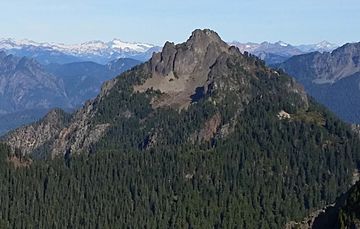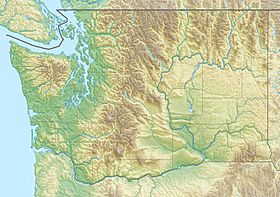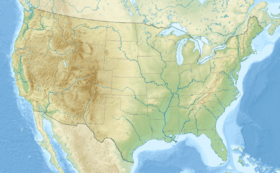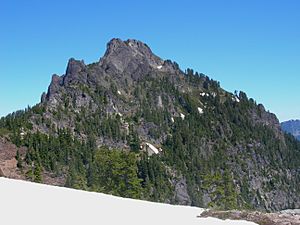Mount Forgotten facts for kids
Quick facts for kids Mount Forgotten |
|
|---|---|

Mount Forgotten seen from Mt. Dickerman
|
|
| Highest point | |
| Elevation | 6,005 ft (1,830 m) |
| Prominence | 2,725 ft (831 m) |
| Isolation | 4.48 mi (7.21 km) |
| Parent peak | Mount Pugh (7,201 ft) |
| Geography | |
| Location | Snohomish County, Washington, U.S. |
| Parent range | North Cascades Cascade Range |
| Topo map | USGS Bedal |
| Type of rock | Volcanic breccia |
| Climbing | |
| Easiest route | class 3 scrambling |
Mount Forgotten is a tall mountain in Snohomish County, Washington state. It stands 6,005 feet (1,830 meters) high. This mountain is found near the western edge of the North Cascades mountain range.
Mount Forgotten is about five miles north of Barlow Pass. It is close to the Mountain Loop Highway and the Monte Cristo area. The land around the mountain is managed by the Mount Baker-Snoqualmie National Forest. The closest taller mountain is Mount Pugh, which is about 4.22 miles (6.79 km) to the northeast. Rain and melted snow from Mount Forgotten flow into small streams that join the Sauk River.
Climate Around Mount Forgotten
Mount Forgotten is in a special climate zone called the marine west coast climate. This means it gets a lot of moisture from the Pacific Ocean. Most weather systems start over the Pacific Ocean and move towards North America.
When these weather systems reach the Cascade Mountains, the tall peaks force the air to rise. As the air goes up, it cools down and drops its moisture. This causes a lot of rain or snow to fall on the western side of the North Cascades. This process is called Orographic lift.
Because of the ocean's influence, the snow here is often wet and heavy. This can make avalanches more likely. Temperatures on the west side of the Cascades rarely go below 0°F (-18°C) or above 80°F (27°C).
In winter, it's usually cloudy. But in summer, high pressure systems over the Pacific Ocean often bring clear skies. The best time to visit or climb Mount Forgotten is usually from July through September.
How Mount Forgotten Formed
The North Cascades mountains have very rugged shapes. They have sharp peaks, long ridges, and deep valleys carved by glaciers. These different shapes and huge changes in height have created many different climates. These climates then lead to different types of plants and animals in the area.
The Cascade Mountains started forming millions of years ago, during the late Eocene Epoch. This happened because the North American Plate was slowly moving over the Pacific Plate. This movement caused many volcanic eruptions.
Glacier Peak, a large volcano, is about 15.35 miles (24.70 km) east of Mount Forgotten. Mount Forgotten itself is made of volcanic breccia. Breccia is a type of rock made from broken pieces of volcanic rock cemented together. Also, small pieces of the Earth's crust, called terranes, helped form the North Cascades about 50 million years ago.
Over the past two million years, during the Pleistocene period, huge sheets of ice called glaciers moved across the land. They scraped away rock and left behind debris. The U-shaped valleys you see today were carved by these glaciers. The combination of land being pushed up (uplift) and cracks in the Earth's crust (faulting) along with glaciers, created the tall peaks and deep valleys of the North Cascades.
- Check the weather forecast for Mount Forgotten here: Mount Forgotten weather




